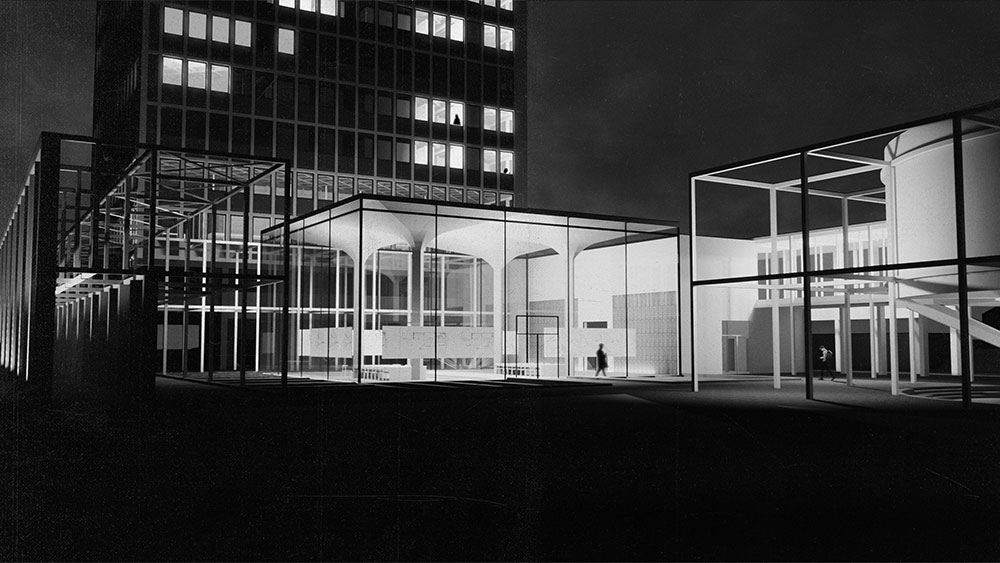Infrastructure Space seeks to find the latent possibilities inherent in things that already exist and to ask how these can be used in the service of society. We are concerned with the productive capacity of existing infrastructure and the combination of systems into new infrastructure, with the aim of addressing environmental issues and their socio-cultural ramifications.
For the first time in the Atelier’s history, we have proudly combined with Landscape Architecture, bringing together MArch2 and MLA2 students, as well as BA3 and MArch1. Through this multi-cohort and interdisciplinary approach, the Atelier utilises multi-methods design thinking to develop inclusive, and diverse outcomes that are both environmentally and ecologically responsive.
The Atelier’s multi-method approach combines four key methods: thematic data mapping, speculative design, stakeholder workshops and exhibitions. The year kicked off with all years working collaboratively to thematically map Cumbria, seeking to elicit new understandings of a territory by visually spatialising and stacking qualitative and quantitative data through a wide range of graphical representations and computational tools. The findings of this mapping were tested and explored at a stakeholder event in Whitehaven (Cumbria) to ensure accuracy, but also to incorporate the nuanced qualitative data from the conversations that took place. The resultant findings were used to identify gaps in knowledge, as well as explore regional opportunities, and/or challenges. The findings of this mapping underpinned the refinement of the students’ project brief.
In November, the Atelier hosted a second stakeholder event alongside an exhibition of the initial designs, including an interactive exhibition by MArch2 and MLA2. The event sought to explore gaps in knowledge through the spatial interrogation of students’ initial assumptions, alongside stakeholders from Cumbria. This event and exhibition utilised design speculation to explore potential outcomes and collect primary data through engagement with stakeholders and a wider public audience. Findings were then developed into design principles through which changes to policy and systems can be proposed or incorporated into the students’ architectural proposals. The students’ resulting proposals were tested and explored alongside our stakeholders at our final event in March 2024.
The methodological approach supported students to not only develop a unique understanding of a place, but also to translate this understanding into novel and realistic solutions. It is within the synthesis of these methods and the wider engagement with stakeholders that this work provides opportunities to have meaningful impact on communities, policymakers, and experts across a range of scales and territories, nationally and internationally.
This year, our MArch1, MArch2 and MLA2 students worked extensively with the Cleator Mill site in Cumbria, a disused flax works and current Park and Ride site for Sellafield nuclear facility. MArch1 students were asked to specifically explore the reuse of the old mill building and surrounding sites. MArch2 and MLA2 were asked to use this site as a case study, through which they could either continue to explore this context or use it to investigate new sites within the territory of Cumbria.
Throughout the year we asked our students to continuously reflect on the Atelier’s questions:
Can an infrastructural architecture be productive in service of humans and the environment simultaneously?
Can the spaces of infrastructural architecture be environmentally, industrially, culturally, and socially productive?
In response to these questions, students developed and continuously explored their own critical positions, considering ideas of reuse, hyper-rural, smart-rural. They were also required to consider the site’s wider context, including the energy sector (nuclear, off-grid, zero carbon technologies), associated transport modes, social, cultural, economic, and political conditions of this complex territory.
The depth and breadth of the students’ enquiry is testament to their ability and skill to investigate, spatialise and propose novel responses. These enquiries have the potential to unlock the productive capacity of existing infrastructures through the combination of systems into new infrastructures that address environmental issues in tandem with their socio-cultural ramifications. It has been a pleasure to work with our ambitious and talented students and we wish them all the best in whatever they choose to do next. Thanks to our staff for their dedication to the Atelier and our students.


